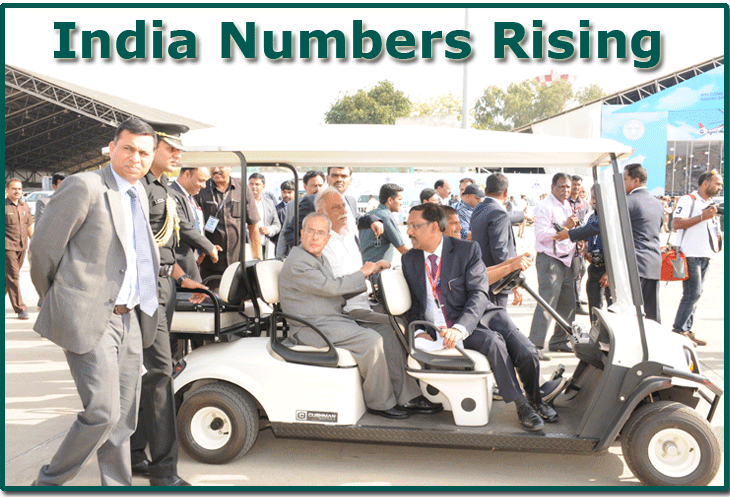
At the recent India
Aviation 2016 Show in Hyderabad, Indian President
Shri Pranab Mukherjee (in gray suit) and Civil
Aviation Minister Shri Ashok Gajapathi Raju Pusapati
in a golf buggy ready to view the static display
of aircraft toured the exhibit area.
|
Over
the last few weeks, a constant refrain in Indian aviation
circles has been that within the next four-five years
the country will become the third largest aviation market
after the U.S. and China. Not without reason: Everyone
has been quoting from a study done by KPMG and apex
chambers of commerce body, FICCI (Federation of Indian
Chambers of Commerce and Industry), called the “India
Aviation Report.” Released
at the recent India Aviation 2016 in Hyderabad (this
was the fifth edition of the exhibition and conference),
the report pointed out that “India is the ninth
largest civil aviation market in the world with a market
size of $16 billion and aims to become the third largest
market by 2020 and the largest by 2030. This is possible
due to a host of factors, including increased competition,
low-cost carriers, modern airports which are expanding,
improved technology in both air side and city side operations,
foreign direct investment (FDI), and increased emphasis
on regional connectivity.” Those words must have
sounded like music to the ears of those handling civil
aviation in the country and, in fact, they were even
better than International Air Transport Association’s
forecast of India achieving the third rank by 2026.
Predictions apart, the
civil aviation leaders in the country do not have cargo
on their radar. At Hyderabad, for example, a lonely
B777 freighter from Etihad that attracted a lot of attention
was on show. What was,
perhaps, worse was that no one in authority (incidentally,
Indian President Shri Pranab Mukherjee inaugurated the
show and Civil Aviation Minister Shri Ashok Gajapathi
Raju Pusapati also spoke) touched on cargo in his or
her speeches. Among the industry leaders there was Airbus’
India President Dr. Srinivasan Dwarkanath, who made
a passing reference to cargo when he said “with
an estimated 10 percent annual traffic growth rate over
the next decade, India will require over 1,600 new passenger
and freighter aircraft in the next ten years.”
Boeing had also projected—though
not at Hyderabad—a demand of 1,740 new airplanes
over the next 20 years in India. While releasing the
annual India Current Market Outlook (CMO) in August
2015, Dinesh Keskar, Senior Vice President of Asia Pacific
and India Sales, Boeing Commercial Airplanes, had no
figures on the number of freighters when he had said,
“Over the next 20 years, Boeing forecasts India
will need 1,740 new airplanes worth $240 billion. India’s
economy and the country’s potential for air travel
growth—both for leisure and business—continues
to be strong and we remain confident in the Indian commercial
aerospace market.”
At present the country
has only seven freighters for the seventh largest economy
in the world and barring one, all are operated by courier
and express major Blue Dart. Those at the helm of civil
aviation in the country are obviously aware of the potential
of the cargo market in the country and with the proliferation
of e-commerce, the projected volumes have increased
manifold. And, so have the problems. In fact, air cargo
stakeholders have often talked about the hurdles faced
by them.
Today, with domestic cargo
volumes growing by the day—largely due to ecommerce—the
problems have multiplied. In fact, matters have come
to such a pass that a number of stakeholders have raised
the issues with the Minister of Civil Aviation as well
as the top bureaucrat in the ministry, the Secretary
of Civil Aviation. One of the top issues, for example,
are the high airport royalty charges. Add to that ground
handling and taxes on ATF and MRO, and the final figure
is “unreasonably high.” The Airports Authority
of India (AAI), which manages 125 airports of which
18 are international airports and 78 are domestic airports,
for example, charges 13 percent of royalty from Indian
MROs. Ground Handling (GH) royalty charges are as high
as 36.3 percent in some airports. Similar charges and
facilities offered by some of the important international
airports abroad vis-à-vis Indian airport charges
and facilities only emphasize the cost ineffectiveness
of Indian airports.
Privately operated Delhi
Airport has been charging 20 percent on MRO services
and 13 percent on Ground Handling services as royalty;
the AAI-controlled Chennai International Airport’s
royalty charges are 13 percent on MRO services and 36
percent on GH services.
Though the AAI has started
an incentive scheme for landing charges for freighters
operated by airlines to and from Kolkata and Chennai
airports—the incentives are as high as 30 percent
for all international scheduled and non-scheduled cargo
freighters depending on the number of flights—the
scheme is only meant for international cargo operators.
The American Chamber of
Commerce in India (AmCham – India), an association
of American business organizations operating in the
country, sent out similar suggestions a few months ago
as “priority issues to be taken up by the government.”
“Air cargo operators
are faced with a multitude of charges—royalty
for ground handling services, royalty charges on security
services, landing, and navigation charges, etc. These
airport charges taken together have created an extremely
high cost environment for cargo handling, which has
substantially deterred their hub development,”
the note said.
Apparently, the elusive
National Civil Aviation Policy (NCAP)—which is
scheduled to make its appearance by the end of April—will
have a lot of sops for the cargo sector. Air cargo stakeholders
will know the level of interest the ministry of civil
aviation has when the NCAP does come.
Tirthankar Ghosh
|





